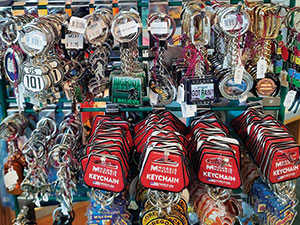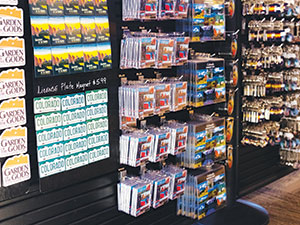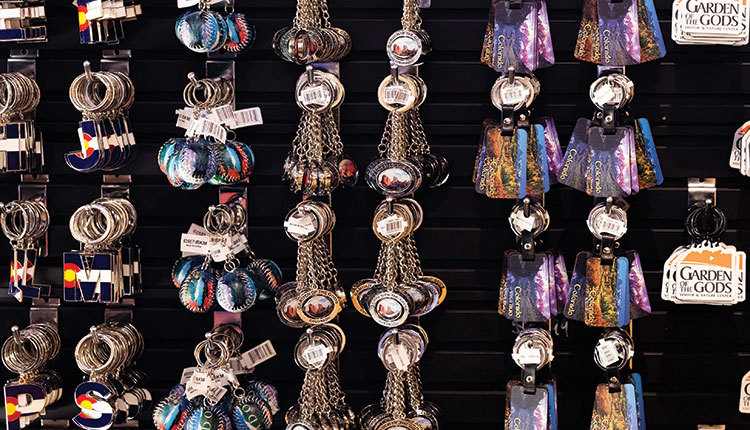Maximize the popularity of souvenir magnets and keychains with unique displays that appeal to customers.
Few souvenirs have wide-ranging appeal the way that magnets and keychains do. Just about everyone owns or uses a refrigerator or has a set of keys — both perfect places to adorn with tokens from trips to tourist attractions. Not to mention most everybody has a few extra dollars laying around to purchase these products, which come in a plethora of styles for all ages, genders and tastes and are easy to take home.
“Magnets and keychains are universal,” explains Joe Skorheim, wholesale sales manager for Morris Magnets, a manufacturer of wholesale souvenirs based in Monroe, Washington. “The market demographic for magnets and keychains is broad — anyone from children to adults can enjoy them.”
Given their small size, destination retailers can also stock plenty of magnets and keychains without much hassle.
“We say put as many designs out that are relevant to your area,” shares David Statman of Better Magnets.
Statman notes that it’s a good idea for destination retailers to regularly update their magnet and impulse souvenir designs to attract customers new and old alike.
Skorheim adds that small souvenirs have high sell-through rates, making them great for destination retailers. Although a sweatshirt is a higher ticket item, Skorheim explains that retailers will likely sell six to seven times more magnets than sweatshirts.
Since these small souvenirs can be such hot sellers, destination retailers should consider being strategic in how they showcase magnets and keychains.
Place for perfectionMagnets are always popular souvenirs at the Columbia River Maritime Museum store in Astoria, Oregon.
Director of Retail Blue Anderson says the shop sells over 4,500 magnets each year. Keychains are also regular sellers, but at about half the quantity as magnets, she notes.
Knowing that these two items are easy sells, Anderson likes to keep them in the back to encourage people to browse other categories scattered throughout the 1,800-square-foot museum store on their way to these small collectibles.
“I consider magnets, postcards and general souvenir items as the bread-and-butter of our store,” she shares. “Mainly they get put a little farther back in the store so people go through other areas before they get to the ‘butter.’”
Statman says retailers with a lot of space might want to try featuring a magnet wall to showcase these souvenirs.
“A lot of people have been doing magnet walls lately with how popular magnets have become,” he says.
It also doesn’t hurt to move these souvenirs occasionally to see what works best.
“We are always moving merchandise,” says Deanna Kindell, director of retail operations and donor engagement at the Armstrong Air & Space Museum in Wapakoneta, Ohio.
 Keychains that feature Oregon themes are popular at the Columbia River Maritime Museum. The northwestern Ohio museum renovated its gift shop in January by updating fixtures to make it more welcoming. Kindell explains that she’s still testing where merchandise will sell best with the new shop layout. But even once she finds a fit for various products, she notes that she’s open to changes, especially for impulse souvenirs.
“Right now, keychains are on an end cap and postcards are across from our checkout, closer to the door,” she says. “But our impulse items are really forever moving because sometimes we have found that when you move them, they sell better — especially for repeat guests.”
Showcase varietyHaving plenty of options and styles of magnets and keychains is a good strategy.
The gift shop at the Garden of the Gods Visitor and Nature Center in Colorado Springs, Colorado, carries a wide range of magnet designs. Store Director Scott Quine says the store has magnets that feature retro styles, artistic styles and some with classic photographs of the Garden of the Gods. There are different shapes as well, including rectangular sized magnets, panoramic-style magnets, mini magnet sets and even some 3D options.
“We started carrying a line of designer clay magnets from Clay Critters,” Quine says. “They’re more like 3D magnets.”
Anderson says her shop’s most popular magnets feature the museum name along with the Astoria name drop. But she also has options that feature the Oregon state flag and Bigfoot to offer variety.
She also makes sure to have some “useful” magnet and keychain options, such as keychains that have fidget spinners or magnets that double as bottle openers.
“When the economy feels slower, I add more ‘useful’ gifts, such as the bottle opener magnets and keychains,” says Anderson.
Skorheim says offering a wide variety of magnet and keychain designs will also appeal to more people.
For instance, one customer who loves hiking might really be drawn to the Bigfoot-themed magnet while another customer who had a work trip in the city might like the magnet featuring a picture of the city’s skyline, he explains. “Give people a couple of things to pick from — variety helps.”
Statman adds that retailers should also try to offer promotions around magnets to increase sales in this category.
“We have a couple clients selling magnets for $5.99, while everyone else is selling them for $4.99,” he says.
“We’ve found the best way to sell a magnet is maybe sell one for $5.99, but then offer two for $10 deals. That way you’re selling in volume. Magnets are great margin since people will pick up two of them all day long.”
Changing the store’s selection of magnets and keychains is also good to boost sales in this category with repeat customers. Kindell says she’s constantly varying up the Armstrong Air & Space Museum shop’s magnet offerings. Currently, an astronaut Snoopy magnet is very popular for the shop, along with some 3D magnet options.
“Our magnets come in many sizes and vary in price,” says Kindell. “Our least expensive is $2, but they go up to $20.”
The museum shop also carries quite a variety of keychains, featuring astronauts, rocket ships and other space themes. Kindell says a metallic astronaut keychain is the bestseller for that product category.
 Garden of the Gods’ gift shop puts magnets and keychains right next to each other.
“It seems like it’s no longer the least expensive item but what meets people’s needs that appeals to them, whether that means it’s made in the USA or handmade,” Kindell explains. “They’re willing to spend more for something that’s fair trade, even with the keychains and magnets.”
Engaging displaysPresenting magnets and keychains together on the same display can also work very well for destination retailers, enticing customers to buy their favorite design of each souvenir.
Skorheim says retailers should try to put several impulse souvenirs together to help encourage sales. He says Morris Magnets offers some display options that allow retailers to showcase magnets, keychains, stickers, ornaments and coasters all together.
At the Garden of the Gods Visitor and Nature Center gift shop, Quine says he likes to surround magnets with other complementary items.
“I think surrounding your magnets with comparable items is helpful,” he says. “I try to put them with other items to create a story.”
For example, Quine explains that he has placed a magnet that says “Garden of the Gods,” with a lanyard around it and bottle opener next to it.
“I try to put ‘like’ items nearby,” he says. “A magnet is a pretty routine purchase for visitors. I use this as an opportunity to show them other items they might not have thought of but now see in conjunction with the magnet.”
With magnets, Skorheim says retailers will want to always keep displays full and replace magnets as the displays empty.
At the Columbia River Maritime Museum shop, Anderson places magnets and keychains on large floor spinners. She adds that she tends to group these products by story. “We theme the spinners — all the bottle openers are together, the museum magnets together, the PNW magnets together, stories like that,” she says.
Kindell has her museum shop’s magnets on a strip display with bins underneath with each of the options for customers to purchase to ensure the displays are never empty.
Kindell is also a big fan of making sure the store’s displays invite customers to pick up and feel merchandise before they buy it. She encourages staff members to showcase how the souvenirs work. She wants customers to pick up and play with a fidget-spinner keychain or feel the 3D magnet before buying it.
“It’s about giving customers an experience,” she shares. “Whether they make a purchase, they can have a great experience in the store.”
|



